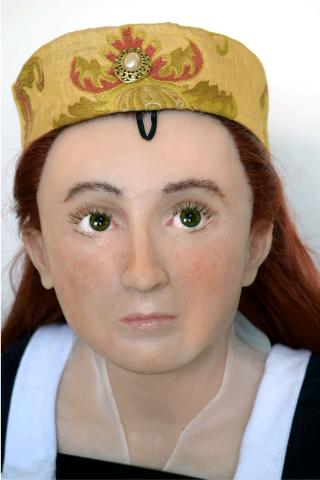"Face of a Plantagenet child bride" : LAMAS in the Sunday TimesThe 67th volume of the LAMAS Transactions (2016) features a piece by Bruce Watson and William White on the child princess, Lady Anne Mowbray, married into the House of York at the apex of the Wars of the Roses at just the age of eight, and whose skeleton was found in the '60s beneath the street of Minories in East London. The article examines past and present knowledge on the child's skeletal remains, and its findings were picked up by The Times (published in print on November 25th 2017). Read it on The Times Online, or check it out below! |
 The new reconstruction of Lady Anne Mowbray’s face by Amy Thornton for John Ashdown-Hill |
Face of a Plantagenet child bride
Norman Hammond, Archaeology Correspondent. The Times.
The face of a Plantagenet princess has been reconstructed from her skeleton, while her bones and hair have yielded data on her stature and health at the time of her death in 1481. The remains of Lady Anne Mowbray also have the potential to illuminate one of English history’s greatest mysteries: the fate of the Princes in the Tower. Lady Anne was the daughter of the Duke of Norfolk, his only child and, after his death in 1476, the greatest heiress in England. Edward IV got papal leave to have her married to his younger son, Richard, Duke of York, in 1478, although she was related to the Plantagenets and both were legally too young to marry. However, Anne died before her ninth birthday, leaving Richard a widower at the age of eight. Interred in Westminster Abbey, she was later ejected by Henry VII in 1502 when he built his own mortuary chapel at the eastern end. Her coffin was then reburied in St Clare’s Abbey near Aldgate, the home of her mother, the dowager duchess of Norfolk.
In 1964 a digging machine uncovered her vault while clearing wartime bomb damage, as Bruce Watson reports in Transactions of the London and Middlesex Archaeological Society. Dr Francis Celoria of the London Museum (now the Museum of London) realised from the finely engraved plate on the lead coffin who was inside it and set up a multidisciplinary scientific investigation to study her remains. A fuss in parliament and in the press about the failure to obtain a burial licence curtailed the study, and its results have never been fully published. They do, however, show that she was about 4ft 4in tall — small for a modern child of nine, but the norm until the late 19th century due to deficiencies in diet. Her hair had high levels of arsenic and antimony, perhaps from her medicines, and she seems to have suffered from ill-health. When her body was prepared for burial her shroud appears to have been treated with beeswax and decorated with gold leaf or thread, and a separate cloth covered her face.
“Individuals like Anne who are precisely dated are vital, so her remains are of international importance. A recent survey of more than 4,600 juvenile burials from 95 British medieval and early post-medieval sites included no named individuals”, so their precise dates of birth and death could not be ascertained, Mr Watson notes.
Of more general interest was a congenital dental anomaly — missing upper and lower permanent second molars on the left side — that Lady Anne shared with the two juvenile skeletons found in the Tower of London in 1674, assumed to be those of her husband, Richard Duke of York, and his brother, King Edward V (the Princes in the Tower). The bones, which are interred in a splendid marble urn in Westminster Abbey, have not been examined since 1933, but reanalysis of photographs has suggested that the two juveniles were 13½-14½ and 11½-12½ years old when they died. If they were indeed the bones of Edward V and his brother, then the overlapping spans show that they could have died in 1484, pinning the blame on their uncle, King Richard III (The Times, May 21, 1987). A slightly later date in the reign of Henry VII is also possible, Mr Watson says, but “the debate over the identity of these undated juveniles will continue until their remains are re-examined. They could be radiocarbon dated and DNA extracted to confirm if they are related to each other and to Richard III.”
Since Richard’s skeleton was discovered five years ago and intensively studied before his reburial in 2015, his DNA is available and a link through the male Plantagenet line could be established, Mr Watson notes. Despite many suggestions in recent decades that the putative remains of the Princes in the Tower should be subjected to the minimal sampling needed using modern technology, the authorities at Westminster Abbey (a “Royal Peculiar” outside the Church of England’s control) have resisted.
“It is extremely rare for the remains of named pre-Reformation individuals to be studied in England,” Mr Watson says. Richard III’s rapid interment without perhaps even a shroud was “completely untypical and can be attributed to the unexpected manner of his death”. Anne Mowbray’s burial was that of an aristocrat with royal links and “undoubtedly of value to our understanding of death and burial during the late 15th century”. The new reconstruction shows us how her princely bridegroom may have seen her.


